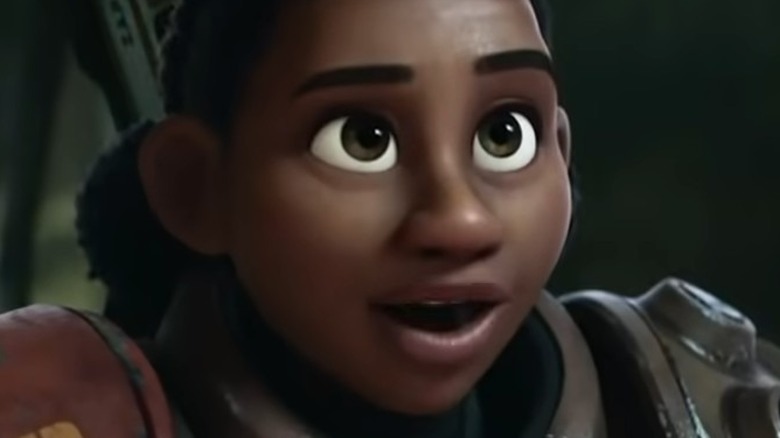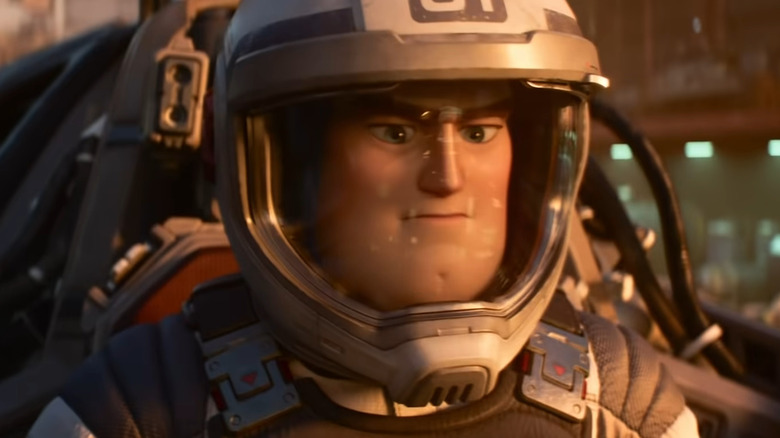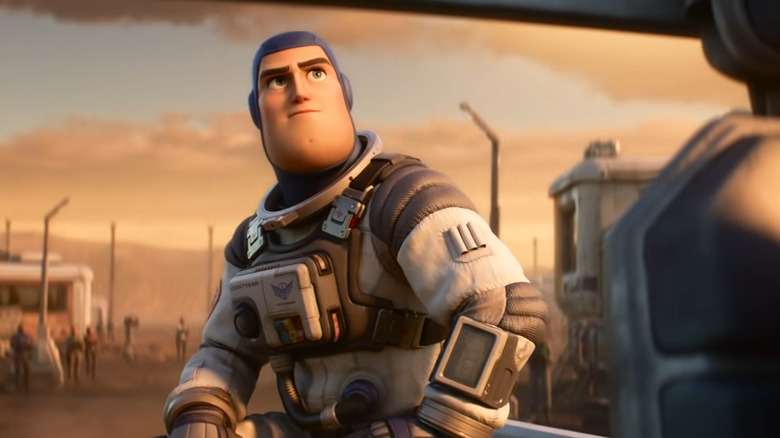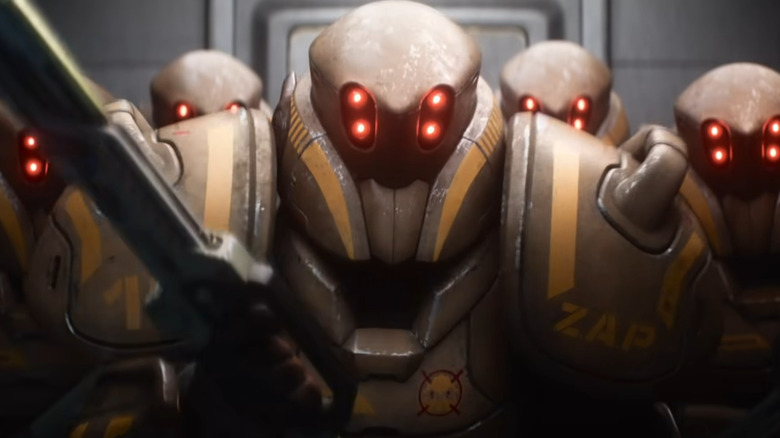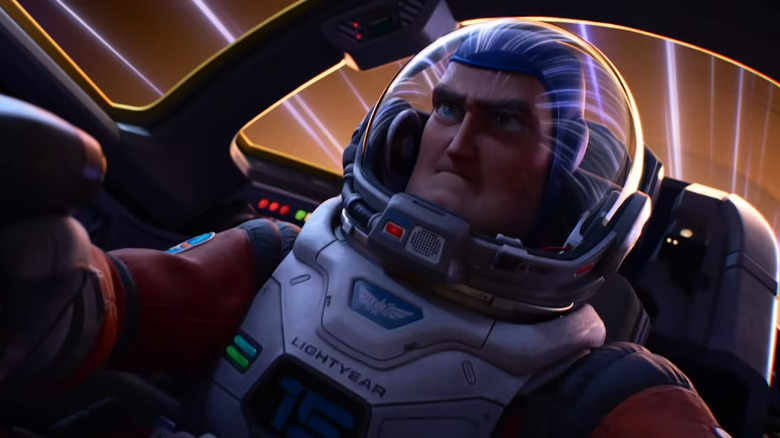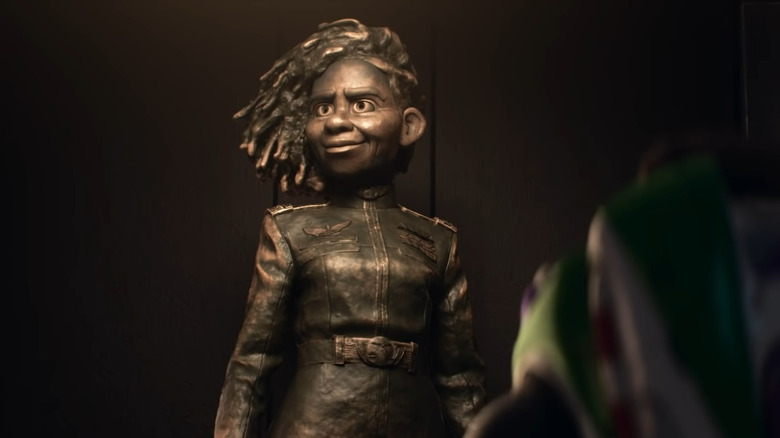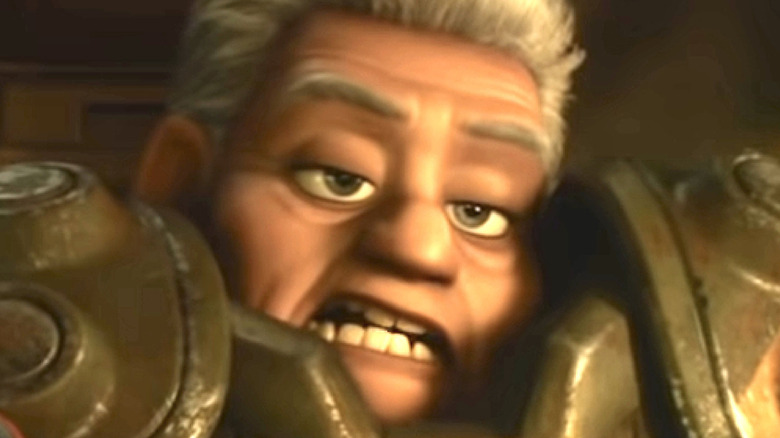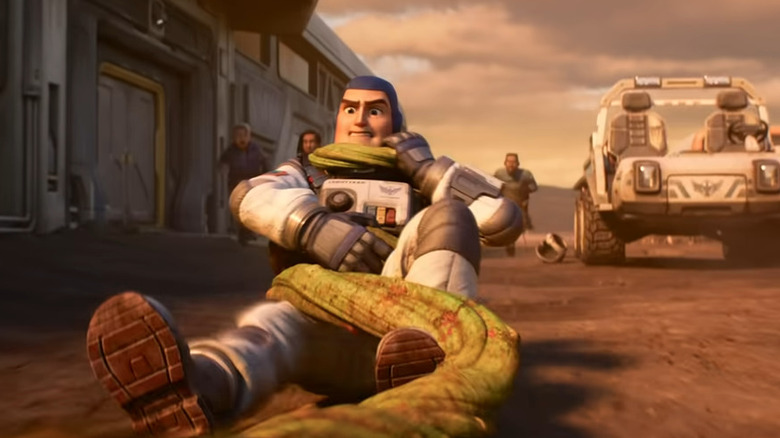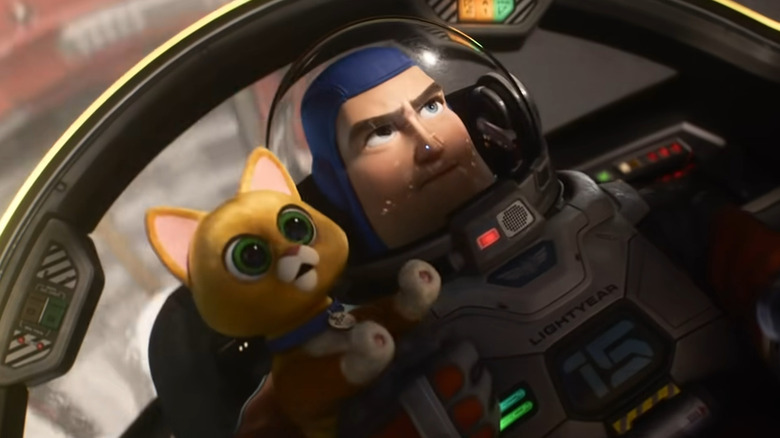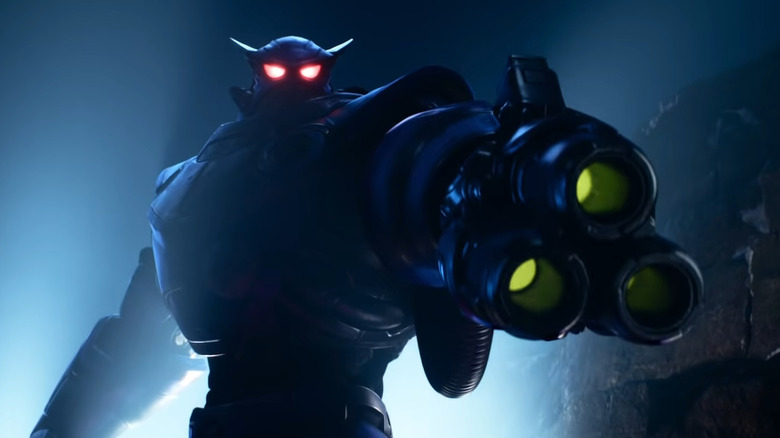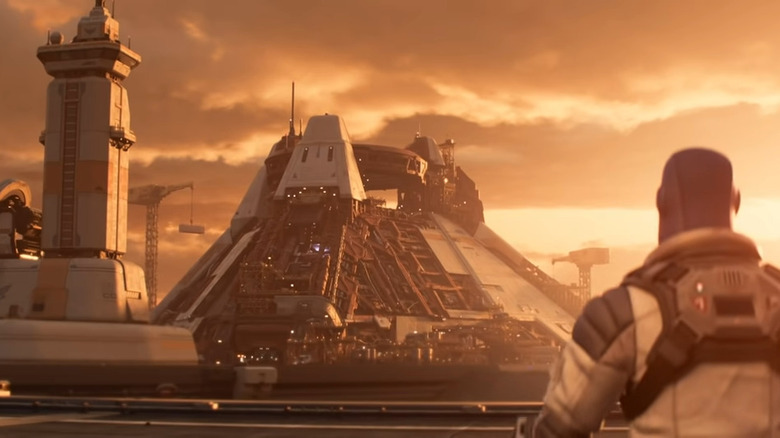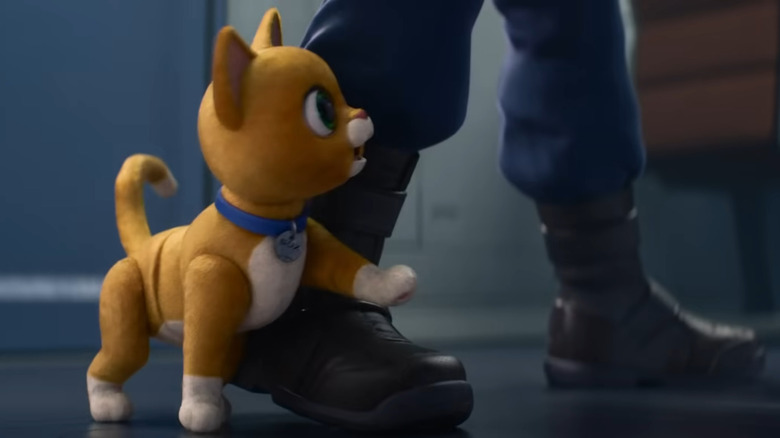Things Only Adults Notice In Lightyear
With "Lightyear," Pixar has delivered both a feature spinoff to the "Toy Story" franchise and a fun sci-fi adventure story in its own right. The film succeeds pretty well in both of those pursuits, adding yet another quality offering to the studio's already prestigious resume. In true Pixar fashion, "Lightyear" balances kid-oriented content with some more mature material — themes and details that only older viewers of the Chris Evans film will fully grasp.
Again, this is nothing new for the studio. In 2004, "The Incredibles" delivered an exciting retro superhero story that also dealt with the nuances of a struggling marriage. "Up" is a fun adventure with talking dogs and airships, but it's also a melancholy tale about living with grief. Even the "Toy Story" movies themselves handle challenging topics like family, belonging, loyalty, pride, and sacrifice. Does "Lightyear" reach those Olympian peaks of Pixar's past? Not quite, but it does feature a number of little touches that most kids will probably miss.
From depictions of mental health struggles to warnings against corrupt institutions, "Lightyear" has a lot of serious messages percolating just beneath the surface — arguably too many for its own good. It's a movie that tries to do a lot in just 105 minutes, and while it doesn't pull it all off, it certainly leaves plenty to dig into. Here are some things in "Lightyear" that only adults will notice.
This article contains spoilers for "Lightyear."
The workaholic storyline
Buzz Lightyear is a workaholic — in a real, scientific, medically diagnosable kind of way. Per Healthline, symptoms of work addiction include "putting in long hours at the office, even when not needed," "being obsessed with work-related success," "having intense fear of failure at work," "using work as a way to avoid relationships," and "working to cope with feelings of guilt or depression," among others. As it happens, all those signifiers fit Buzz Lightyear to a T.
Even before the Turnip gets stranded, Buzz shows numerous instances of work obsession. He's a by-the-book operator who doesn't like working with rookies, and he holds himself to the highest possible standard. It's hinted later that this behavior may stem from a larger inferiority complex. Buzz reveals that he wasn't especially good at boot camp, and that he almost quit after his first week. Despite achieving great success in Star Command since then, he's no less hard on himself.
Things only become magnified after the Turnip becomes stranded — an accident for which Buzz exclusively blames himself. He's so fixated on fixing what he sees as his mistake that he willingly lets go of his friends, relationships, and life as a whole in order to undergo the repeated hyperspeed tests. "Lightyear" keeps a pretty upbeat tone for the majority of its runtime, but older viewers will surely clock that Buzz is in a pretty bad place for a lot of the story. Fortunately, he eventually finds a way out.
Buzz's mental health arc
Some contemporary studies have suggested that work addiction is correlated with a higher risk of depression, and in "Lightyear," Buzz shows symptoms of both. His obsession with his "mission" is largely motivated by his own self-loathing, and he acts as if he isn't deserving of a normal, happy life. During the decades he spends testing the hyperspeed drive, Buzz is the only one repeatedly pushing for more runs. His best friend, Commander Alisha Hawthorne (Uzo Aduba), even encourages him to stop, but that's still not enough to break Buzz out of his pattern.
This fixation on guilt and past mistakes is a primary symptom of depression, as is Buzz's lack of interest in his everyday life (per Mayo Clinic). Given how long the character has been around, and how iconic he has become, it's significant to see him grappling with his own mental health struggles. While this might seem a little dark, Buzz is written deftly enough that he doesn't come off too serious to younger audiences — and, of course, he finds some proper peace by the end of the movie.
After defeating Zurg and returning safely to the Star Command colony with his crew, Buzz says that he feels like he's home for the first time in a long time. After working so closely with Izzy (Keke Palmer), Mo (Taika Waititi), and Darby Steel (Dale Soules), he recognizes some of the ways in which he'd closed himself off and makes strides to address his own personal struggles.
If you or someone you know is struggling with mental health, please contact the Crisis Text Line by texting HOME to 741741, call the National Alliance on Mental Illness helpline at 1-800-950-NAMI (6264), or visit the National Institute of Mental Health website.
Lightyear's anti-institution narrative
Buzz Lightyear may work for Star Command, but that doesn't mean that they're the good guys. On the contrary, Star Command acts as a direct antagonist before Zurg shows up on the scene. When Buzz returns home from a test flight to find that Alisha has passed away, he quickly realizes that the new command structure is no longer interested in hyperspeed experiments. Star Command even tries to decommission Sox (Peter Sohn), which Buzz refuses to allow. He ultimately ends up stealing a spaceship and undergoing another test flight in complete disobedience to the organization's orders. By the time he gets back, Zurg has taken over.
Because the Zurg storyline then takes center stage, "Lightyear" doesn't have too much time to spend on the state of Star Command. That's a shame, because there seem to be some major problems rooted within the institution. Commander Burnside (Isiah Whitlock Jr.) displays an almost ignorant level of disregard for the space program, preferring to hide behind his beloved laser shield for protection. He's just about ready to lock Buzz up for his dissenting opinions, and he'd probably go through with it if Buzz didn't defeat Zurg.
Ultimately, "Lightyear" doesn't spend much time ruminating on the incompetence of Star Command, which makes the whole subplot easy to forget. But for more discerning viewers, there's still a clear message — it's the people you trust, not the institutions they serve, who you should put your faith in.
So many classic sci-fi references
"Lightyear" has a lot of Easter eggs, including a heavy load of "Toy Story" references. It also pays frequent homage to the sci-fi greats of yore. To be fair, even some of those allusions may be caught by kids who love the genre, such as Sox's R2-D2-style computer hacking and Zurg's many similarities to Darth Vader. Others, however, are clearly written specifically for the adults in the audience.
For instance, when Buzz's first test flight goes wrong, he starts arguing with the ship's autopilot system and orders it to "open the fuel door." The computer responds by saying, "I'm sorry, I didn't quite catch that." The whole exchange is a clear reference to Stanley Kubrick's "2001: A Space Odyssey," but seeing how that's a film that's wholly inappropriate for young children, only the adults will get the joke.
There are also a lot of stylistic homages to even older science fiction tales like "Buck Rogers." The alien planet that Buzz and company find themselves on feels very retro — giant bugs, vicious sentient vines, craggy wasteland, the whole shebang. This makes sense, given that the original idea for the Buzz Lightyear character drew heavily from old sci-fi series like "Space Patrol." In an age when the original "Star Wars" trilogy is seen as retro, these older references likely won't be caught by the kids, but they add a stylish texture for older fans.
The significance of Commander Hawthorne's queerness
Slowly but surely, Pixar has expanded its films' LGBTQ+ representation in recent years, and "Lightyear" continues that trend with an onscreen kiss between Commander Hawthorne and her wife. It's a fleeting moment — one you'd probably miss if you blinked at the wrong time, and which could be seen as yet another instance of queer representation being relegated to the sidelines. Yet in the greater context of modern animated family films, it's still a notable step.
Arguably more important than the kiss itself, however, is how Alisha and her family are portrayed overall. She's not shown as an exception to some rule, but rather as a kind of gold standard for what a healthy family life can look like. Buzz's obsession with work keeps him from finding that kind of joy, which puts him in stark contrast to Alisha's work-life balance. This decision is especially significant because it centers a queer marriage as the normal standard to aspire to, not some kind of "alternative lifestyle." It makes queerness foundational, rather than making it ancillary.
This is equally true in regards to Izzy, Alisha's granddaughter who ends up helping Buzz defeat Zurg. LGBTQ+ grandparents aren't the most common characters in big-budget movies, and it's meaningful to see all the ins and outs of Alisha's relationship with Izzy. Though the kiss itself is brief, "Lightyear" has a much more extensive message about queer representation. Queer spouses are normal, queer parents are normal, and queer grandparents, you guessed it, are normal too.
Darby Steel is the most interesting character in Lightyear
Tired of all the heavy themes in "Lightyear?" Great, because this one's just fun.
There are a number of wacky characters in "Lightyear," but Darby Steel (voiced by Dale Soules) might be the wildest of them all. An elderly ex-convict, the majority of her history is left shrouded in shadow, but the little bits and pieces that are revealed paint a picture of a shrewd and crafty career criminal with a penchant for arson and grand theft. When asked directly why she was arrested (her junior patrol work is court-mandated), she says that she stole a spaceship. However, the film repeatedly alludes to her doing way, way more than that.
Darby's special talent, as described by her peers, is that she can make a bomb out of pretty much anything. What does that skill have to do with stealing a spaceship, you might ask? On paper, nothing, which begs the question: Why does Darby know how to make bombs? For that matter, why was she trying to steal a spaceship? It's easy to assume that she was simply looking for a joyride or wanted to sell it for parts, but the rest of her characterization makes this unlikely. Clearly, she's been in the game for a very long time, and it's likely that the crime she was imprisoned for was part of an even bigger scheme. We can only hope for a Darby spinoff somewhere down the line.
Confusing environmental undertones
While not explicitly an environmentalist narrative, "Lightyear" nevertheless has some eco-undertones sprinkled across its 105 minutes. However, these themes are also a bit confusing in their presentation, making the film's actual environmental stance somewhat muddled.
For starters, the environment is presented as an antagonist for most of "Lightyear." The alien planet that Star Command crashes on is pretty inhospitable for human occupation, and it takes the crew of the Turnip a number of years to figure out how to manage. Even when things get better, there isn't any real coexistence with the planet's natural ecosystem. Commander Burnside's solution, which is seen in effect at the end of "Lightyear," is to build a massive laser shield around the entire colony. It's not a very nuanced plan, and Burnside isn't presented as a particularly shrewd leader, but the laser shield is the only real solution that the movie seems to offer.
How are we, as viewers, to read this? Buzz Lightyear, the film's lead protagonist, scoffs at the whole laser shield idea and works tirelessly to get humanity back into space. But that goal is also presented as a bit obsessive. So what's the message? That humans should look to their own environment before trying to escape into space? That modern (or rather, futuristic) society must be kept separate from the natural world? "Lightyear" touches on a lot of these topics, but it never seems quite sure of what it wants to say.
The fickle past
Two of the larger overarching themes in "Lightyear" are the passage of time and the inevitability of change — ideas that definitely play to the young crowd in some ways, but which are much more fully understood by adult viewers. At first, Buzz pays little attention to the changing world around him. He doesn't care about how the colony is adapting to its environment or how his culture is changing around him — he's only interested in solving the hyperspeed problem and returning things to how they used to be. Later on, this resistance to change rears its head as a full-on villain, with Zurg revealed to be an old version of Buzz from the future (voiced by James Brolin).
Over the course of the story, Buzz comes to terms with the fact that time passes — that things change, for better or worse, and there's nothing you can do about it. Sure, you can waste your days obsessing over how things could have gone differently, like Zurg does, but then you're stuck. The past, for all of its latent potential, isn't alive. It's not worth dying for because we can never go back to it. At least, that's what "Lightyear" seems to suggest.
This idea is central to the whole story of the film, but the real weight of the message will be lost on most younger viewers.
Zurg's anti-change agenda
Zurg, aka Evil Buzz Lightyear, wants one thing — to travel back in time to before the Turnip ever crashed, thereby undoing what he sees as his greatest mistake. At first blush, it sounds like a nice idea — a chance to undo a tragedy and restore humanity to its place among the stars. But in reality, Zurg's motivations are far more self-serving. He wants to retroactively change his legacy, making himself a hero in the eyes of history rather than a failure. But as shown in Buzz's arc, most people don't view him as a failure. Even Burnside is impressed upon finally meeting Buzz and says that he looked up to him as a kid. But Zurg isn't interested in what actually happened in the past. He's only interested in his own twisted, warped perception of it.
Zurg's quest is no longer about guilt or fixing his mistakes — it's about claiming power and control. When Buzz objects to the idea of turning back the clock, Zurg starts to view him as a threat. "So many new ideas," he laments as Buzz tries to stop him. Clearly, Zurg isn't interested in new ideas. He's only interested in a specific version of the past where he's the one on top.
The allegory here isn't too complicated — Zurg thinks he's making space great again, but he's only destroying lives. In the modern age we live in, it's a storyline that may ring far heavier for the adults in the audience.
Lightyear looks unbelievable
In 1995, Pixar made its feature film debut with the theatrical release of "Toy Story." To put it simply, the movie was a revelation — the first fully computer-animated feature film ever made. At the time, "Toy Story" was a technical marvel — a crowning achievement of what artistry and technology could accomplish in tandem. Decades later, though, it kind of just looks ... old.
That's not a knock on "Toy Story" — it's a fact of innovation, and boy has Pixar innovated in the years since it first started making feature films. Kids going to see "Lightyear" may have some appreciation for how stunning it looks, but if you're old enough to have been following the studio since 1995, the movie is infinitely more impressive. From the intricate detail on every facial animation to the sweeping vistas of space, "Lightyear" has it all, and it arguably beats out every one of its predecessors in terms of sheer visual splendor. It's honestly a shame that the story takes place almost entirely on a single, rocky planet. Looking at the magnitude of what Pixar is able to accomplish visually, it's hard not to want ice planets, lava planets, nebulas, and supernovas.
What we get in "Lightyear" is still plenty impressive, though. Pixar even developed new technology for "Lightyear" in IMAX — a testament to just how far the studio has come and how hard they're still pushing the envelope for animation.
Alisha and Sox are the real heroes of Lightyear
Being a Pixar movie, "Lightyear" ends on a happy note: With the help of Mo, Darby, and Izzy, Buzz defeats Zurg and returns to the colony safe and sound. Commander Burnside is so impressed that he asks Buzz to lead the new iteration of the Space Ranger Corps. But if you're watching the movie with discerning eyes, you'll notice that the real heroes of the story are Sox and Alisha Hawthorne.
First, let's talk about Sox. Not only does he provide Buzz with unceasing emotional support — something that he desperately needs and surely wouldn't succeed without — but he's also the one who figures out how to create a new, functional crystallic fusion core. He saves Buzz from capture multiple times, fixes the ships when they break down, and does countless other things to ensure that the mission succeeds. Sox does more than almost anyone else in the movie, and he deserves a huge portion of the credit.
That brings us to Alisha Hawthorne. An accomplished Space Ranger in her own right and the matriarch of a proud family, Alisha is impressive in myriad ways. But her most significant contribution to the actual mission in "Lightyear" is when she gifts Sox to Buzz. Of course, at the time, she's only thinking of the emotional support, but Sox quickly proves himself to be capable of a lot more. Turns out, pets really do save lives.
